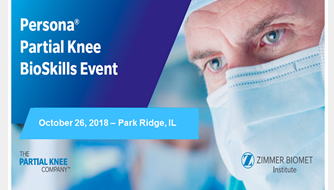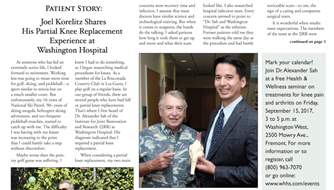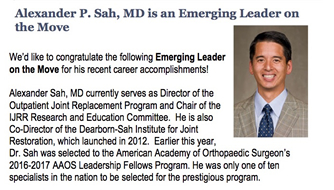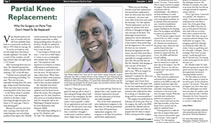PARTIAL KNEE REPLACEMENT

Partial knee replacement is similar to total knee replacement in that it is a resurfacing procedure. However, partial knee replacement refers to resurfacing only one of the compartments of the knee. The inside, the outside, or the kneecap area can be treated independently of the others. This option is appropriate for patients who have pain and arthritis isolated to a single portion of the knee.
I have extensive training in partial knee replacement since residency and fellowship. I was fortunate to train with Dr. Richard Scott in Boston and Dr. Richard Berger in Chicago who have some the nation’s greatest expertise in partial knee replacement. I have subsequently published papers on the topic (see below), teach surgeons at courses how to perform the minimally invasive technique, and lecture as faculty at meetings on partial knee outcomes and advanced outpatient protocols.
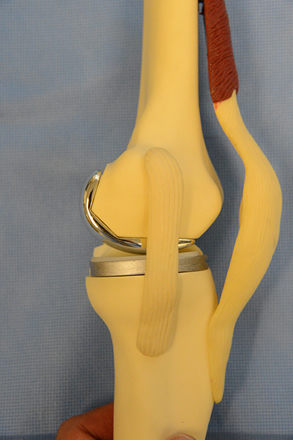
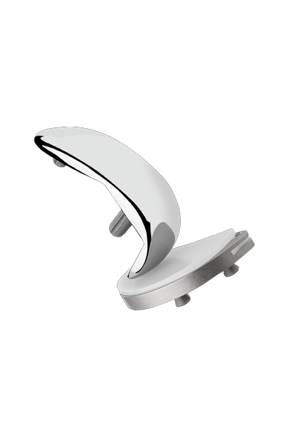
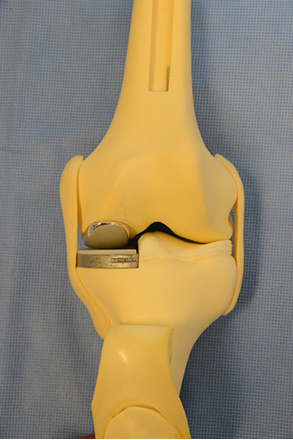
Patients must be promptly identified with isolated or early arthritis to benefit most from the procedure. While total knee replacement is also a reliable option in these situations, partial knee replacement has the following potential benefits:
- bone preservation
- all ligaments spared
- less blood loss
- less invasive surgery
- better knee range of motion
- faster recovery
- a more normal feeling knee
With enhanced pain management protocols, this procedure is routinely performed on an outpatient, home same day, basis for my patients. I created the outpatient program in Fremont in 2014, and lecture at our national hip and knee meetings on the advancement of outpatient surgery.
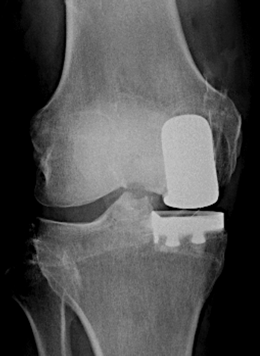
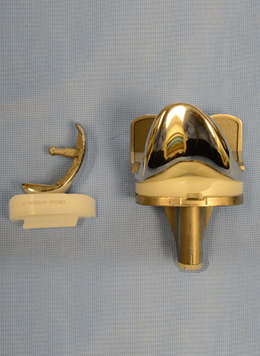
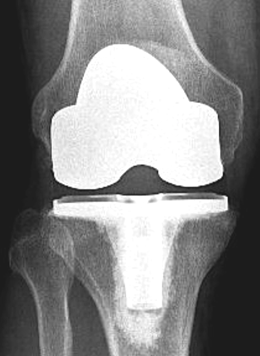
Studies have shown that partial knee replacement can be durable up to 15 years and beyond in the correctly chosen patient. In addition, if arthritis develops elsewhere in the knee, a partial knee replacement can be converted to a primary, or first-time, total knee replacement.
In 2016, I performed the most Zimmer Unicompartmental fixed bearing partial knee replacements in California, the thirteenth most in the United States. In addition, I performed the 5th most partial patellofemoral (kneecap) partial knee replacements in the United States.* I often serve as faculty to teach other surgeons how to perform partial knee replacement. I am the United States Lead Investigator of the new Persona Partial Knee System and participate in clinical research in partial knee replacement.
*based on industry database 2016
⇒ Read about patient's experiences after joint replacement at Sah Orthopaedic Associates in Testimonials, or see Patient's Stories after surgery to learn more. ⇐
Advancing the field with Technology in Orthopedics, I have thoroughly evaluated and subsequently chosen to work with some of the most innovative and revolutionary technologies in orthopedics.
- Computer navigation is commonly described in modern joint replacement procedures. While not necessary in all cases, navigation is useful and available in select cases.
- Wearable motion sensors can help engage patients during their recovery phase, providing reliable and accurate real-time feedback to both the patient and surgeon.
- Dr. Sah is the only surgeon to have the ability to offer an Apple Watch for patients to assist during joint replacement recovery.
- Dr. Sah has done research on soft-tissue balancing sensors used during the surgical procedure to provide a more precise outcome.
- Game Ready cooling therapy is commonly used by elite athletes and patients recovering from hip and knee surgery.
Talk to Dr. Sah and his team to find out more, and to see if these technologies may benefit you.
Minimally Invasive Partial Knee Replacement Surgery
Same day partial kneecap replacement
Outpatient partial knee replacement surgery
Read a patient's experience with partial knee replacement in this article:
For more information, read this PDF below:
Partial Knee Ongoing Research
- Lead investigator of United States, Zimmer Persona Partial Knee evaluation, 2016-present
- Principal Investigator, Zimmer Persona Partial Knee Surgeon Evaluator 10 year followup, 2017-present
Teaching Surgeons Advanced Techniques
- Faculty, Persona Partial Knee Surgical Training Course, Las Vegas 2017
- Faculty, Persona Partial Knee Surgical Training Course, Phoenix 2018
- Faculty, Persona Partial Knee Surgical Training Course, Chicago 2018
Partial Knee Presentations
Dominkus, Parratte, Alexander Sah, “Clinical 2-year Outcomes of the Personal Partial Knee- A Prospective Multicenter Study”
Poster at 22nd EFORT Congress, Austria, 2021
Alexander Sah, Sebastien Parratte, “A new morphometric fixed-bearing medual UKA: minimum 2-years follow-up results of a prospective multicentric study”
Presentation at Western Orthopedic Association Annual Meeting, 2020
Matsuda, Paratte, Alexander Sah, “Two-year global followup of Persona Partial Knee”Presentation at TJOSKAS-JOSSM Annual Meeting, Japan, 2020
Alexander Sah, Sebastien Parratte, “A new morphometric fixed-bearing medual UKA: minimum 2-years follow-up results of a prospective multicentric study”
Presentation at The Partial Knee Meeting 2020, Belgium, 2020
Alexander Sah, “Extramedullary spacer block technique for unicompartmental knee arthroplasty- results of 300 consecutive patients”
Poster at 12th Bieenial ISAKOS Congress, Mexico, 2019
Alexander Sah, “Minimum one-year follow-up of a recently released fixed bearing partial knee replacement system- Result of a prospective multi-center worldwide controlled study by a group of non-developing surgeons”Poster at Orthopedics Today Annual Meeting, Hawaii, 2019
Alexander Sah, “Extramedullary spacer block technique for unicompartmental knee arthroplasty- results of 300 consecutive patients”
Poster at AAOS Annual Meeting, Las Vegas, 2019
Alexander Sah, “Outcomes of a Unique Milling System Technique for Patellofemoral Arthroplasty”
Poster at Western Orthopedic Association Annual Meeting, CO, 2018
Alexander Sah, Persona Partial Knee Surgical Training Course
Faculty, Las Vegas, 2017
Alexander Sah, “The Evolution of Unis- from outcast to outpatient”
Presentation at Contemporary Solutions in Joint Surgery, Salt Lake City, 2017
Alexander Sah, “Evolution of Partial knee replacement”
Presentation at Zimmer Biomet Sales Meeting, Indianapolis, 2017
Alexander Sah, “Historical Evolution of Partial Knee Replacements”
Presentation at West Regional Recon Hip and Knee Meeting, San Francisco, 2016
Alexander Sah, “Patellofemoral Arthroplasty with a Milling System Technique- Early results, minimum 2 year followup”
Presentation at ICJR 3rd Annual Pan Pacific Orthopedic Congress, Kona, Hawaii, 2016
Alexander Sah, “Extramedullary Technique for Unicompartmental Knee Arthroplasty- Early results, minimum 2 year followup”
Presentation at ICJR 3rd Annual Pan Pacific Orthopedic Congress, Kona, Hawaii, 2016
Alexander Sah, “Unicompartmental Knee Replacement- History and Evolving Indications”
Presentation at Contemporary Solutions in Joint Surgery, Newport Beach, 2016
Alexander Sah, “Partial knee replacement- Tips and Technique”
Presentation at Contemporary Solutions in Joint Surgery, Newport Beach, 2016
Alexander Sah, “Partial Knee Replacement- advances in surgical techniques & same day discharge”
Presentation at PhysicalTherapy.com, webinar, 2016
Alexander Sah, “Results of unicompartmental knee arthroplasty with an extramedullary technique”
Poster at Orthopedics Today Meeting, Hawaii, 2015
Alexander Sah, “Early results of patellofemoral arthroplasty with a milling system”
Poster at Orthopedics Today Meeting, Hawaii, 2015
Alexander Sah, “Unicompartmental Knee Arthroplasty”
Presentation at California Orthopedic Association Meeting, Laguna Niguel, 2011
Sebastien Parrette, Alexander Sah, Richard Scott, Jean-Noel Argenson, “Unicompartmental knee arthroplasty for Spontaneous Osteonecrosis- a Multicentric Study”
Presentation by Dr. Parrette at AAOS Annual Meeting, San Francisco, 2008
Alexander Sah, Richard Scott, “Lateral UKA through a medial approach”
Presentation at AAOS Annual Meeting, San Diego, 2007
Alexander Sah, Bryan Springer, Richard Scott, “Survival of the Prosthesis beyond the Patient- UKA in Octogenarians”
Presentation at OREF New England Resident Research Symposium, 2006, Mass General Hospital
Alexander Sah, Bryan Springer, Richard Scott, “Unicompartmental Knee Arthroplasty in the Octogenarian”
Poster at AAOS Annual Meeting, Chicago, 2006
Partial Knee Publications
Riff AJ, Sah AP, Della Valle C. Outcomes and Complications of Unicondylar Arthroplasty. Clinics Sports Medicine, 2014;33(1):149-60.
Sah AP, Scott RD. Lateral unicompartmental knee arthroplasty via a medial approach- Surgical Technique. J Bone Joint Surg. 2008;90S:195-205.
Sah AP, Scott RD. Lateral unicompartmental knee arthroplasty via a medial approach- Study with an average 5-year follow-up. J Bone Joint Surg. 2007; 89:1948-54.
Sah AP, Springer BD, Scott RD. Unicompartmental Knee Arthroplasty in Octogenarians- Survival Beyond the Patient. Clin Orthop Rel Res. 2006;451:107-12.
Springer BD, Scott RD, Sah AP, Carrington R. McKeever Hemiarthroplasty of the Knee in Patients Less Than Sixty Years- Old. J Bone Joint Surg. 2006;88:366-71.

Partial knee replacement is similar to total knee replacement in that it is a resurfacing procedure. However, partial knee replacement refers to resurfacing only one of the compartments of the knee. The inside, the outside, or the kneecap area can be treated independently of the others. This option is appropriate for patients who have pain and arthritis isolated to a single portion of the knee.
I have extensive training in partial knee replacement since residency and fellowship. I was fortunate to train with Dr. Richard Scott in Boston and Dr. Richard Berger in Chicago who have some the nation’s greatest expertise in partial knee replacement. I have subsequently published papers on the topic (see below), teach surgeons at courses how to perform the minimally invasive technique, and lecture as faculty at meetings on partial knee outcomes and advanced outpatient protocols.



Patients must be promptly identified with isolated or early arthritis to benefit most from the procedure. While total knee replacement is also a reliable option in these situations, partial knee replacement has the following potential benefits:
- bone preservation
- all ligaments spared
- less blood loss
- less invasive surgery
- better knee range of motion
- faster recovery
- a more normal feeling knee
With enhanced pain management protocols, this procedure is routinely performed on an outpatient, home same day, basis for my patients. I created the outpatient program in Fremont in 2014, and lecture at our national hip and knee meetings on the advancement of outpatient surgery.



Studies have shown that partial knee replacement can be durable up to 15 years and beyond in the correctly chosen patient. In addition, if arthritis develops elsewhere in the knee, a partial knee replacement can be converted to a primary, or first-time, total knee replacement.
In 2016, I performed the most Zimmer Unicompartmental fixed bearing partial knee replacements in California, the thirteenth most in the United States. In addition, I performed the 5th most partial patellofemoral (kneecap) partial knee replacements in the United States.* I often serve as faculty to teach other surgeons how to perform partial knee replacement. I am the United States Lead Investigator of the new Persona Partial Knee System and participate in clinical research in partial knee replacement.
*based on industry database 2016
⇒ Read about patient's experiences after joint replacement at Sah Orthopaedic Associates in Testimonials, or see Patient's Stories after surgery to learn more. ⇐
Advancing the field with Technology in Orthopedics, I have thoroughly evaluated and subsequently chosen to work with some of the most innovative and revolutionary technologies in orthopedics.
- Computer navigation is commonly described in modern joint replacement procedures. While not necessary in all cases, navigation is useful and available in select cases.
- Wearable motion sensors can help engage patients during their recovery phase, providing reliable and accurate real-time feedback to both the patient and surgeon.
- Dr. Sah is the only surgeon to have the ability to offer an Apple Watch for patients to assist during joint replacement recovery.
- Dr. Sah has done research on soft-tissue balancing sensors used during the surgical procedure to provide a more precise outcome.
- Game Ready cooling therapy is commonly used by elite athletes and patients recovering from hip and knee surgery.
Talk to Dr. Sah and his team to find out more, and to see if these technologies may benefit you.
Minimally Invasive Partial Knee Replacement Surgery
Same day partial kneecap replacement
Outpatient partial knee replacement surgery
Read a patient's experience with partial knee replacement in this article:
For more information, read this PDF below:
- Lead investigator of United States, Zimmer Persona Partial Knee evaluation, 2016-present
- Principal Investigator, Zimmer Persona Partial Knee Surgeon Evaluator 10 year followup, 2017-present
- Faculty, Persona Partial Knee Surgical Training Course, Las Vegas 2017
- Faculty, Persona Partial Knee Surgical Training Course, Phoenix 2018
- Faculty, Persona Partial Knee Surgical Training Course, Chicago 2018
Partial Knee Publications
Riff AJ, Sah AP, Della Valle C. Outcomes and Complications of Unicondylar Arthroplasty. Clinics Sports Medicine, 2014;33(1):149-60.
Sah AP, Scott RD. Lateral unicompartmental knee arthroplasty via a medial approach- Surgical Technique. J Bone Joint Surg. 2008;90S:195-205.
Sah AP, Scott RD. Lateral unicompartmental knee arthroplasty via a medial approach- Study with an average 5-year follow-up. J Bone Joint Surg. 2007; 89:1948-54.
Sah AP, Springer BD, Scott RD. Unicompartmental Knee Arthroplasty in Octogenarians- Survival Beyond the Patient. Clin Orthop Rel Res. 2006;451:107-12.
Springer BD, Scott RD, Sah AP, Carrington R. McKeever Hemiarthroplasty of the Knee in Patients Less Than Sixty Years- Old. J Bone Joint Surg. 2006;88:366-71.


